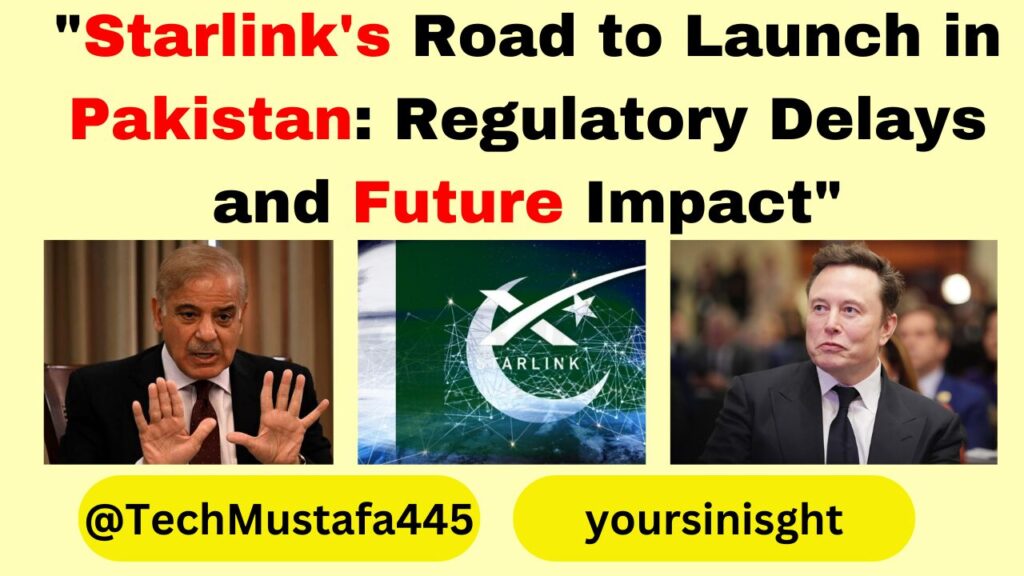Table of Contents
Introduction: In the era of rapid digital transformation, access to fast and reliable internet is no longer a luxury; it’s a necessity. However, many regions across the globe, particularly remote and underserved areas, continue to face challenges with internet connectivity. This is where Starlink, the satellite internet service launched by SpaceX, has the potential to make a significant impact. By using a network of low-Earth orbit (LEO) satellites, Starlink aims to provide high-speed internet to areas that traditional broadband infrastructure can’t reach.
In Pakistan, a country that has long struggled with digital connectivity, particularly in rural and mountainous regions, Starlink’s promise of providing internet service without relying on existing ground-based infrastructure has been seen as a game-changer. However, the journey for Starlink in Pakistan hasn’t been straightforward. Despite the excitement surrounding its potential, the service is still waiting on critical government approvals to officially launch.
The Growing Need for Better Internet Access in Pakistan
Pakistan is home to a population of over 230 million people, many of whom reside in rural areas where internet infrastructure is sparse or non-existent. While mobile internet has become more accessible in recent years, broadband connectivity remains unreliable in many parts of the country, limiting access to essential services like online education, telemedicine, and business opportunities.
This digital divide has driven interest in Starlink, which can bypass the need for traditional internet infrastructure. With satellite-based internet, Starlink could provide affordable and reliable high-speed internet to communities that have been overlooked by conventional broadband providers. The technology promises to bring a new wave of digital connectivity to places where it was once impossible.
The PTA’s Role in Starlink’s Approval
For Starlink to launch in Pakistan, it first had to go through the Pakistan Telecommunication Authority (PTA), which oversees the country’s telecommunications sector. In October 2024, the PTA made an important move by announcing that it would grant Starlink a license to operate in the country. This approval came after Starlink had submitted its application and addressed various regulatory requirements.
However, the approval wasn’t immediate, and it was only after months of discussions that the PTA gave Starlink the green light to proceed with setting up operations. Despite the positive outcome, there was still one major hurdle: security clearance. The Pakistani government needed to ensure that Starlink’s operations aligned with national security policies and telecommunications regulations, particularly given the concerns over foreign companies operating satellite systems within the country.
Waiting for the Final Approval
In the months following the PTA’s decision, Starlink began preparing its infrastructure and started making plans for its rollout. However, the crucial security clearance from the government remained pending, and this delay has kept the service from launching.
Elon Musk, the CEO of SpaceX, addressed the situation publicly, stating that Starlink was “waiting for approval from the government.” This statement reflected the frustration felt by both Starlink and many Pakistani citizens, who were eagerly anticipating the service’s arrival. Despite the regulatory progress, the wait for security clearance stretched on, further delaying the company’s plans.
For Starlink, operating in Pakistan means adhering to strict government regulations regarding the use of satellite technology, as well as ensuring that the service does not pose a threat to national security. Pakistan, like many countries, is cautious about foreign satellite services and wants to ensure that these systems do not interfere with national interests.

The Potential Impact of Starlink in Pakistan
Once Starlink finally receives its security clearance and is able to launch, the potential benefits for Pakistan are immense. For a country that has long struggled with digital connectivity, Starlink could bridge the gap by offering fast, reliable internet across its vast rural areas. This would improve access to education, enable better healthcare services, and boost economic activity by providing businesses with the tools they need to compete in a digital world.
Starlink’s service could also provide a competitive alternative to existing telecommunications providers, which often struggle to offer reliable services in underserved areas. By offering high-speed internet via satellite, Starlink could bring a much-needed innovation to Pakistan’s broadband market, which could lead to improved services from local internet service providers as they adapt to the competition.
Moreover, Starlink’s service could be particularly beneficial in emergencies. In a country like Pakistan, where natural disasters such as floods and earthquakes often disrupt traditional communication networks, having a satellite-based internet service could provide critical connectivity when it’s needed most.
What’s Next for Starlink in Pakistan?
As of January 2025, Starlink is still waiting for final approval from the Pakistani government to launch. Although the PTA has given the green light for the service’s operation, the delay in receiving security clearance means that Starlink’s services are not yet available to the public. The company has been making preparations in the background, but without the necessary clearance, it cannot begin its commercial rollout.
While the situation remains uncertain, there is hope that the Pakistani government will soon clear the way for Starlink to begin its operations. The PTA’s initial approval signals a positive outlook, and with the growing demand for digital connectivity across Pakistan, there is strong anticipation that Starlink’s launch will be a milestone in the country’s digital transformation.
Conclusion
Starlink’s entry into Pakistan is a story of anticipation, challenges, and the potential for transformative change. As the service waits for the final clearance from the government, the excitement continues to build among Pakistani citizens who see it as a lifeline to the world of high-speed internet. If and when Starlink is fully approved and launched, it could offer a much-needed solution to the digital divide, particularly in rural areas, and help shape the future of connectivity in Pakistan. For now, all eyes remain on the government’s next move—hopefully, one that will unlock the door to a connected future for millions of Pakistanis.